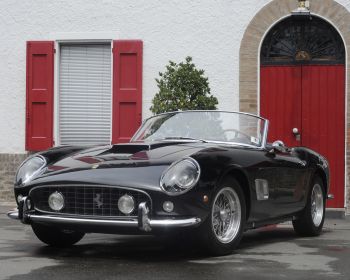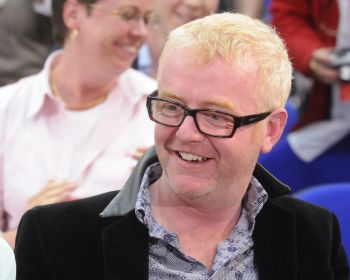
 |
|
The Ferrari Leggenda e Passione auction event
at the weekend witnessed
a new Ferrari auction record established for a
1961 Ferrari California Spyder (top) formerly owned by
actor James Coburn which was purchased by DJ Chris Evans (above). |
|
|
|
Car
enthusiasts and Ferrari collectors from across the globe descended on Ferrari’s
home, Maranello, at the weekend (17-18 May 2008) for
RM Auctions second annual Ferrari Leggenda e Passione auction event and to witness
a new Ferrari auction record established for a
1961 Ferrari California Spyder formerly owned by
actor James Coburn.
The rare car exceeded all
expectations by selling for a world record auction price for
a vintage car at auction in the amount of 7,040,000 euros surpassing the previous record set at
Sotheby's Monaco in 1990 for a 1962 Ferrari 250 GTO at
US$10,756,000.
Among the attendees was one
extremely well known Ferrari enthusiast, BBC Radio DJ Chris
Evans. Chris, accompanied by his wife, golf pro and writer
Natasha Shishmanian, attended the Gala reception on Saturday
17 May where he fell for the considerable charms of a 1961
Ferrari 250 GT SWB California Spyder. The following day,
Chris made a successful bid of 7,040,000 euros for his dream machine, which will now take pride of place in
his own celebrated collection.
1961 Ferrari
250 GT SWB California Spyder
Specifications: 280bhp, 2,953cc, single overhead camshaft,
single outside plug, roller rockers, alloy block and head
V-12 engine with three Weber 40 DCL 6 carburettors,
four-speed gearbox, independent front suspension via A-arms,
coil springs and telescopic shocks and live axle,
semi-elliptical springs and telescopic shock absorber rear
suspension, and four wheel hydraulic disc brakes. Wheelbase:
2,400mm (94.5 in.)
Many Ferrari aficionados consider the 250 GT SWB California
Spyder one of the most beautiful and functional cars ever
made. Certainly the actor James Coburn did. With body work
designed by Pininfarina and built by Scaglietti, the car was
a collaboration between the very best.
“I am lucky
enough to remember that afternoon in 1951 when my father was
driving back to Turin from Tortona in his B20, with me at
his side. In Tortona we had met Enzo Ferrari in a restaurant
and, over lunch, we had discussed the terms of a possible
partnership. Both Ferrari and my father were proud men and
neither had wanted to give the other the privilege of
playing host. So they had decided to meet halfway. In a way
they already knew each other: they had met several times at
motor shows. They respected each other very much and had
probably already sensed what they could achieve by working
together. On his part, Ferrari had no coachbuilder at
Maranello and had always had to go out and look for the
best. He had already worked with some of the most famous
names of the day such as Ghia, Touring and Vignale. Some of
the results had been excellent, but despite its wonderful
racing tradition, even Touring seemed hesitant whether or
not to continue. And Ferrari, as he has often been quoted as
saying, realised that his cars needed an image of their own
and using different designers only added to the kind of
confusion he wanted to avoid. He believed that Pinin Farina
could give him what he had in mind.
"My father wanted to match his creative instinct with a
product of the highest quality; he had ambitious plans to
invest and expand and was confident that the future would
repay the risks and initial sacrifices. Ferrari was the best
of all possible opportunities: a young company that had
already won itself prestige and sporting glory, able to
offer him the chance of creating something really new.
"No other company, not even the biggest and most famous,
could have given him the same freedom and the same
incentive, because it already had a heritage of its own and
traditions that he would have had to respect. Ferrari, on
the other hand, was like a King without a crown and my
father’s great idea was to give it an image and a
personality of its own. His ideal was to make “his” Ferrari
the symbol of the sports car par excellence.” This is Sergio
Farina’s recollection of the start of Pinin Farina’s
collaboration with Ferrari and it is particularly poignant
in that the partnership between the two, along with Sergio
Scaglietti, would go on to produce some of the most
beautiful and sensational cars that the world has ever seen.
Scaglietti was started in 1951 as a car repair shop and was
located across the road from Ferrari’s operations in Modena.
A true artisan, Scaglietti’s skills in design and
coachbuilding ensured an enduring relationship with Enzo
Ferrari. While he was alive, Ferrari’s son Dino would spend
a lot of time at the Scaglietti workshop absorbing
everything that was going on. Scaglietti was responsible for
some of the most stunning designs of the 1950s and 60s and
became the preferred Carrozzeria for Ferrari competition
cars. Following the infamous ‘walkout’ of several Ferrari
employees, including Giotto Bizzarrini, Scaglietti took over
Bizzarrini’s 250 GTO design. Simplifying the lines and
refining the shape, the result was one of the most beautiful
of all Ferraris.
Ferrari recognised the contribution that the sale of road
cars could make to financially support the scuderia’s sports
and grand prix racing, and the appeal of production
convertibles in particular became apparent. They were
readily marketable to a select clientele in Europe and
particularly attractive to the burgeoning market in North
America served by Luigi Chinetti and John von Neumann, which
was so important to Ferrari’s cash flow. To respond to this
market Ferrari created two legendary series, the cabriolets
and the spyders.
The 250 GT Pinin Farina Series II Cabriolets were based upon
Ferrari’s first volume series built production cars, the 250
GT Pinin Farina Coupés, and like the PF coupé they were
nicely trimmed and fitted for everyday use and long trips.
Combining the exciting performance of Ferrari’s race-proven
3.0-litre V-12 with the excellent handling and supple ride
of the 2,600 mm wheelbase chassis, the Series II 250 GT PF
Cabriolet had a well-earned and highly justified reputation
as a superb, elegant and understated touring car with
quality interior appointments, soundproofing and
Pininfarina’s classic Ferrari styling.
On the other hand, there was the California Spyder. Also
designed by Pinin Farina, it was based upon the 250 GT Tour
de France, Ferrari’s dual-purpose berlinetta, and it shared
its character: lighter, more responsive and faster, with
characteristics closer to those of a racing car than its
more luxurious stable mates. The California Spyder, first
offered in the 2,600 mm wheelbase of the 250 GT Tour de
France, was developed for a group of performance oriented
drivers who wanted both the pace of the lighter berlinettas
and the open-air feel of a convertible.
In 1959 Ferrari introduced a short wheelbase 250 GT
berlinetta that offered quicker, more responsive handling,
followed a year later by its California Spyder variant.
While the SWB Berlinetta got a new Pinin Farina designed
body, the SWB California Spyder continued with its LWB
sibling’s coachwork, styling only drawn and executed more
tautly and sharply over the shorter length. True
dual-purpose automobiles, they were at home on the streets
of Beverly Hills and the open roads and racing circuits of
Europe and North America.
Many of Ferrari’s clients were wealthy, famous and titled
patrons. In Hollywood, a number of top actors owned
Ferraris, including Steve McQueen, Clint Eastwood and James
Coburn amongst them. Of course McQueen would go on to be an
accomplished racing driver as would Paul Newman and to a
lesser degree James Garner. Another was James Dean who was
killed on his way to race his Porsche 550 Spyder at Salinas,
California.
It may well have been Steve McQueen’s influence that sparked
James Coburn’s interest in fast cars. McQueen was starring
in a successful television show called “Wanted Dead or
Alive” and by the end of the fifties already owned a 1953
Siata 208S, 1958 Porsche Speedster 1600 Super and a 1957
Jaguar XK-SS. He would go on to own a Ferrari 250 GT Lusso
and a stunning 275 GTS/4 NART Spyder. Between 1959 and 1960
James Coburn co-starred with him in three episodes of
“Wanted Dead or Alive”. The McQueen family and James Coburn
would remain friends for life. They co-starred together in
their first feature film, “The Magnificent Seven” in 1960
and another iconic picture “The Great Escape” in 1963 where
they were joined by friend James Garner. Having worked as
second unit director on the movie “Convoy,” Coburn’s
directorial debut, years later he would be on Garner’s TV
show “The Rockford Files.” James Coburn once said, “Actors
are boring when they’re not working, it’s a natural
condition. Because they don’t have anything to do, they just
lay around and that’s why so many of them get drunk.” A good
way to cure boredom is to buy a Ferrari.
CHASSIS NO. 2377GT
The Ferrari 250 GT SWB California Spyder, chassis number
2377 GT is the thirteenth of just fifty-six built. It was
completed on March 5th 1961 and sold new through official
Ferrari importer Jacques Swaters’ Garage Francorchamps in
Brussels to first owner Fredy Damman. In 1964 it was sold,
again via Swaters, to actor James Coburn of Hollywood,
California. This would have been shortly after the end of
filming “The Great Escape.” Coburn had this car tuned up by
Max Balchowsky at his Hollywood Motors. Balchowsky was a
successful racing driver famous for his homebuilt Old Yeller
racing cars. His garage was a popular hangout for
Hollywood’s “genuine car guys” as McQueen, Garner and Coburn
were known and James Dean before them. Coburn would go on to
own other Ferraris including a 1967 412P. 2377 GT is in
wonderful condition, finished in nero (black). The car has
been meticulously maintained over its known ownership and
includes extensive documentation relating to its restoration
and maintenance. With such a wonderful history this car
becomes even more desirable, owned for much of its existence
by James Coburn, a tremendous actor and iconic film star who
starred in some of the greatest films of our age.
Born on 31st August 1928 in Laurel, Nebraska, James Coburn
appeared in over 180 movies and television shows. He died in
November 2002. Known as being “Tall, lean and sporting one
of the biggest grins in Hollywood,” Coburn won an Oscar in
1998 for his role in the film “Affliction.” Coburn shared
the same manager as Steve McQueen, the Hollywood legend
Hilly Elkins. Elkins said of Coburn, “There’ll never be
another like him. When we were kids, he and I and Steve
McQueen hung out together. Those two made an impression on
generations, past, present and future.”
|